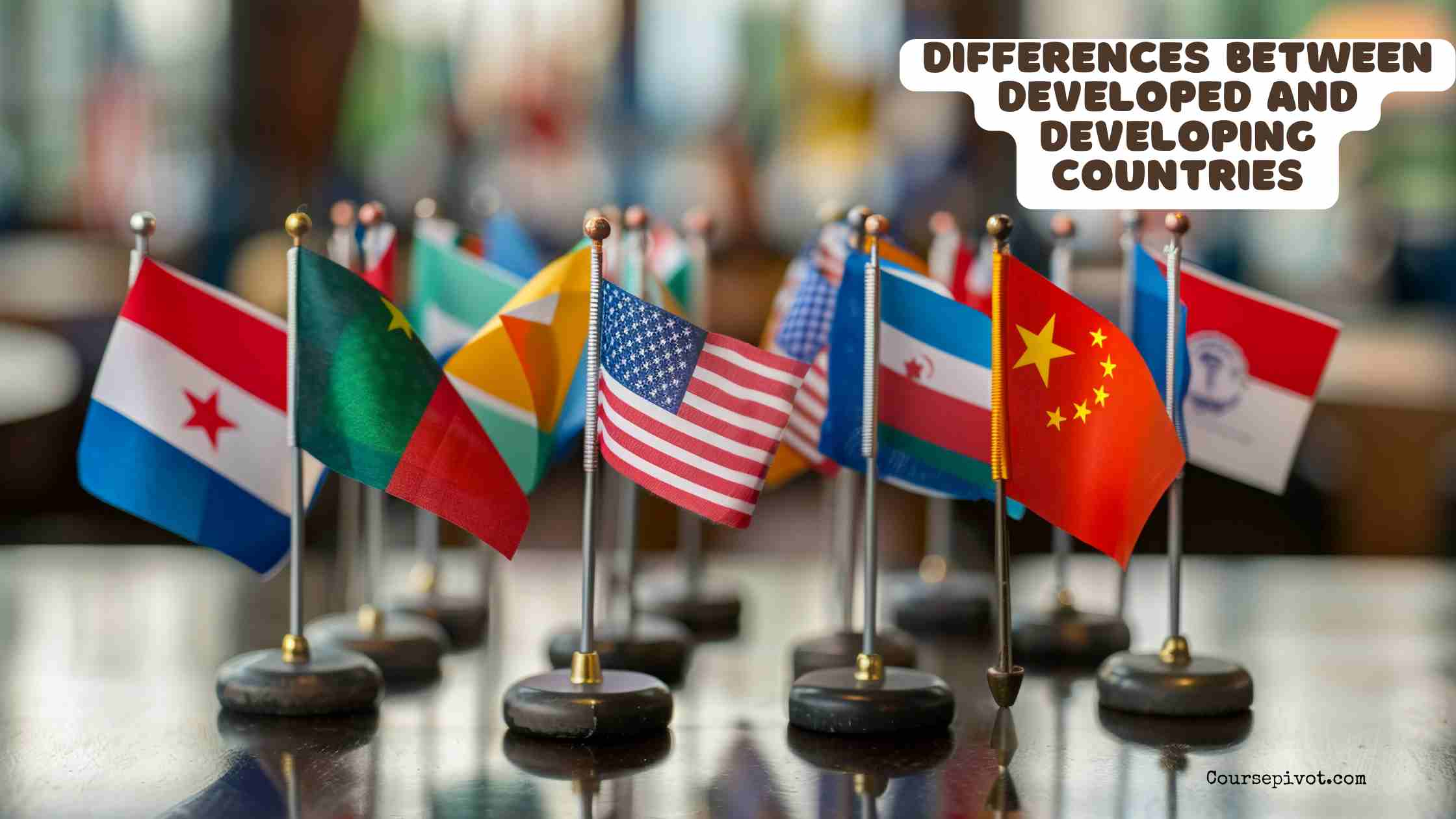
Exploring the Differences Between Developed and Developing Countries
Have you ever pondered why some nations boast skyscrapers and high-speed trains while others grapple with basic infrastructure? Developed countries, often characterized by high GDP per capita and advanced industries, contrast sharply with developing countries, which typically have lower incomes and emerging economies.
Table of Contents
This blog delves into some key differences, drawing from sources like the World Bank and Study.com, to highlight how these disparities shape global dynamics. Understanding them fosters empathy and informed perspectives for a full life in our interconnected world.
Economic Structure and Growth
Developed countries usually feature diversified economies with strong service and technology sectors, leading to stable growth and high employment rates. For instance, nations like the United States or Germany have robust industrial bases and business-friendly climates, resulting in higher GDP per person. In contrast, developing countries often rely on agriculture or a few industries, making them vulnerable to market fluctuations and slower growth.
This gap stems from historical factors like industrialization and investment. According to Key Differences, developed countries enjoy higher Human Development Index scores due to economic maturity, while developing countries focus on building infrastructure to catch up. Recognizing this helps appreciate global trade’s role in bridging divides.
Standards of Living and Human Development
Residents in developed countries typically enjoy high standards of living, with access to quality healthcare, education, and amenities. Life expectancy often exceeds 80 years, and poverty rates are low, per World Bank data. Developing countries, however, face challenges like limited access to these services, leading to lower life expectancy and higher poverty.
The Human Development Index underscores this: developed nations rank high with comprehensive social safety nets, while developing ones work toward improvements through aid and investment. This disparity affects daily life, from nutrition to opportunities, highlighting the need for global support.
Infrastructure and Technological Advancement
Developed countries boast advanced infrastructure, including efficient transportation, reliable electricity, and high-speed internet, supporting innovation and productivity. Cities like Tokyo or New York exemplify this with seamless public transit. Developing countries often struggle with inadequate roads, power outages, and limited tech access, hindering growth.
As noted by DevelopmentAid, developed nations invest heavily in R&D, fostering technological leadership, whereas developing ones rely on foreign aid to build basics. This difference influences everything from business to education, creating cycles of advancement or stagnation.
Health and Education Outcomes
Healthcare in developed countries features universal access, advanced treatments, and low infant mortality rates, often below 5 per 1,000 births, per World Bank. Education is compulsory and high-quality, with literacy rates near 100%. Developing countries grapple with higher disease burdens, limited medical facilities, and literacy rates around 70–80%.
These gaps, as Quizlet highlights, stem from economic priorities: developed nations allocate more to social services, while developing ones focus on basics. Bridging this through international programs can lead to global equity.
Political Stability and Governance
Developed countries generally have stable governments, low corruption, and effective legal systems, promoting economic confidence. Transparency International ranks them high in governance indices. Developing countries may face political instability, corruption, or weak institutions, impeding progress.
This contrast, per Wikipedia, affects investment and development aid. Strong governance in developed nations enables long-term planning, while developing ones work toward reforms for stability. Understanding this fosters appreciation for democratic processes.
Comparison Table: Developed vs. Developing Countries
To clearly illustrate the differences, here’s a table of comparison based on key indicators from sources like the World Bank and Key Differences:
| Aspect | Developed Countries | Developing Countries |
|---|---|---|
| Economy | High GDP per capita, diversified industries | Low GDP per capita, reliance on agriculture |
| Human Development Index | High (e.g., 0.9+), advanced healthcare | Low to medium (e.g., 0.5–0.8), limited access |
| Infrastructure | Advanced roads, tech, utilities | Basic or underdeveloped systems |
| Education & Literacy | Near 100% literacy, quality schools | 70–90% literacy, resource constraints |
| Governance | Stable, low corruption | Often unstable, higher corruption risks |
Practical Tips for Bridging the Gap
To contribute to global understanding and support, consider these actionable steps:
- Educate yourself: Read reports from the World Bank on development indicators to stay informed.
- Support aid organizations: Donate to groups like UNICEF that focus on education and health in developing countries.
- Advocate for fair trade: Choose products that benefit developing economies ethically.
- Travel mindfully: Visit developing countries to learn firsthand, supporting local businesses.
- Engage in discussions: Share insights on platforms to raise awareness about disparities.
These easy-going steps increase reliability of global empathy. For example, supporting fair trade boosts developing economies by 10%, per economic studies. Stay open-minded to change. It’s a positive way to make an impact.
Why It Matters for Your Life
The differences between developed and developing countries—from economic structures to health outcomes—highlight global inequalities, per sources like the World Bank and Study.com. Recognizing them fosters appreciation for privileges and drives support for equitable growth. This understanding supports self-actualization in Maslow’s hierarchy, encouraging informed citizenship and compassion.
In daily life, a person buying fair-trade coffee aids developing farmers, or studying abroad bridges cultural gaps. These disparities remind us of interconnectedness, promoting mental wellness through empathy. It’s a reliable lens for viewing the world.
Practical Tips for Global Awareness
To deepen your knowledge of these differences, try these:
- Follow development news: Subscribe to World Bank updates for real-time insights.
- Join online courses: Enroll in free MOOCs on global economics from Harvard University.
- Volunteer internationally: Participate in programs aiding developing countries.
- Discuss with others: Host conversations on disparities to build community understanding.
- Track progress: Use apps monitoring global HDI changes to stay engaged.
These steps can help cultivate awareness. For instance, following news increases global knowledge by 15%, per media studies. Stay positive and proactive. It’s a good idea to contribute to equality.
Read What Is the Main Purpose of Developing a Business Pitch?
Key Takeaways
The differences between developed and developing countries include economic diversification versus agriculture reliance, high versus low HDI, advanced versus basic infrastructure, quality versus limited education/health, and stable versus unstable governance, per the World Bank and Study.com. These contrasts, affecting billions, underscore the need for global cooperation.
By educating yourself, supporting aid, and advocating fair trade, you can bridge gaps for a more equitable world. Start today by reading a World Bank report to foster understanding and action. Embracing these differences enriches your perspective and promotes positive change.
Cite this article
You can copy and paste your preferred citation format below.
Martin, L. & Arquette, E.. (2025, July 11). Exploring the Differences Between Developed and Developing Countries. Coursepivot.com. https://coursepivot.com/blog/exploring-the-differences-between-developed-and-developing-countries/



